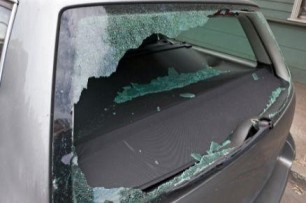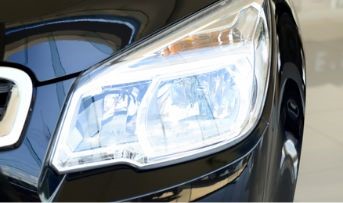General Insurance Blogs, Articles & Updates by - Magma HDI
Have us call you
- RENEW YOUR POLICY
- BUY NEW POLICY

Does your car insurance policy cover damages due to vandalism
There are various covers that the insurance companies provide depending upon factors such as the location, the type of car, the engine model, the engine capacity, etc. These car insurance covers are provided for various situations such as natural calamities, theft, accident, etc. One such protection that always seems ambiguous is the insurance against vandalism. If you are contemplating whether to take a vandalism cover or not, this article might help you by giving you a better insight into destruction, the claim, the benefits, and the demerits of the same.
The first thing to understand is that vandalism covers can be costly. As the severity of vandalism cannot be estimated beforehand, and the likeliness cannot be predicted, the covers can charge extra.
You can claim vandalism only if you have a comprehensive cover. Now, what is a comprehensive cover? Let’s understand the two main kinds of covers provided by insurance companies.
1. A third-party plan:
This policy is a safety net for the policyholder against any liabilities that may arise due to an accident or collision resulting in an accident of a third person or damage to their property.
If in case of death of the third person, the insurance company covers the compensation for the same. The premium on these is lower compared to a comprehensive car insurance plan.
2. A comprehensive plan:
Not only does it include third-party coverage, but it also takes care of personal damage. Comprehensive car insurance protects against any legal obligations arising from third-party interference and covers any damage caused to your car.
This cover also has the added covers on natural and human disasters such as riots and vandalism. With these things in mind, you can rest assured that your car will be fully taken care of by the insurance company.
Let’s first understand what vandalism is:
Vandalism is an act of destruction performed intentionally and with the intent of malice. In this case, we are talking about vandalism against vehicles, which can have different forms.
1. Damage to the car body:
Spray paint, scratches, and graffiti are a few ways to damage the car’s body that can be considered vandalism. More noticeable scratches and damage will require a new paint job and other repairs.
2. Broken parts:
Broken windows, glass panels, or lights must be changed entirely, costing tens of thousands in damage.
3. Slashed tyres and stolen parts:
Parts of your car, such as the side-view mirror, company logo, tyres, wiper blades, etc., can cost significant money. People steal these and sell them for the original prices, which are relatively more expensive than the knock-off goods.
Vandalism claims can be time-consuming and challenging to process as there is rarely a proof. So, it is best to inform your insurers as soon as possible and start the process. But remember that vandalism claims are only valid if there were relevant covers in your policy.
As discussed above, car insurances pay for vandalism only if you have comprehensive coverage added to collision coverage. Comprehensive coverage does not include any stolen goods or personal items from within the car, but it can cover the expenses for the damages incurred.
Sometimes, a police intervention might be needed as vandalism is considered a crime. Filing a complaint with your insurer increases the chances of damage recovery through the claim. If a police officer does not visit the crime scene, then the chances are that they will call you to give a detailed report of the crime. Do not forget to miss out on any points, as the better the details of the crime; the better are your chances of claiming your insurance.
Now you know why investing in a comprehensive car insurance policy is best. You can get the best protection against calamities, human-induced hazards or otherwise.
Click HERE to find out more about comprehensive car insurance plans.
Disclaimer: The information provided above is for illustrative purposes only. To get more details, please refer to policy wordings and prospectus before purchasing a policy.

Replacing your headlights can be a DIY project with the right resources!
When your headlights give you a difficult time by going off, the instant reaction is to contact a mechanic. And why would you not? A broken headlight makes it feel like you are driving with one eye closed, causing night drives riskier. Also, what if a vigilant police officer stops you on the road? That generally means heavy fines, especially if a few things are wonky in your car. Additionally, the car now looks way less sleek than before. However, going to the mechanic proves to be costly and time-taking, which makes you delay the job unless there is a looming fine.
A one-stop solution to all these problems is just fixing the headlight yourself. This surprisingly easy task takes a few minutes to accomplish. It could be a fun DIY project which you undertake this season! This blog gives you the basics of replacing your car headlights at home!
Tool list: You might need the following tools to fix the headlights, so keep them handy: Screwdriver set, socket set, pliers.
Safety first!
There's nothing more important than your safety. Wear gloves and goggles to protect yourself, as you might have to reach some tight spots. Additionally, you'll hold sensitive bulbs throughout the process, which warrants protection.
Caution!
As a precautionary method to ward off DIY enthusiasts, most car insurance companies do not allow significant self-modifications to the vehicle's interiors or exteriors. While checking new car insurance rates, read the policy fine print to check if it permits such changes.
Step-by-step process on how to replace your car's headlights:
1. Check your owner's manual
This is to get specific instructions on replacing your vehicle's headlights and what kind of bulbs you should get (HID or LED). The general instructions are similar, but you may need specific tweaks to suit your car.
2. Power the car down
Turn off your car, let it cool, and park it in a clean area on your driveway.
3. Access the bulbs
This may be a tricky step. Sometimes, you may need to remove the battery to access the bulbs better. Or, you can pop the hood and locate the headlight holder near the front of the car.
4. Detach the headlight connector and disconnect the bulb
The base of the lightbulb is connected by three wires. Disconnect the plug that supplies power to it. Once you open the headlight, changing the bulb is child's play. However, be careful while unlocking the locked bulb out of its place. Try not to break the clips used in locking the bulb, as those are not easily fixable.
5. Screw the new light bulb in
Wearing gloves, carefully screw the new bulb without touching the glass of the bulb, as it may burst. Close the hood of your car, and the job is done! If one headlight is off, it's almost certain the other will go off in a few weeks. So, when replacing one, take some time and replace the other one too.
Headlights going off is a common problem. While it is usually from old age, there can be other reasons, such as extreme heat or cold, which affects the bulb's filament, causing it to go off. It can also be due to oxidation, common in modern-day halogen bulbs. Unfortunately, you might have to replace the whole headlight, not just the bulbs. In this case, taking the vehicle to a mechanic is best, as meddling with it too much might do more harm than good. To make this more pocket friendly, research new car insurance rates that also undertake your car's repair and maintenance costs.
Click HERE to know more about new car insurance rates.
Disclaimer: The information provided above is for illustrative purposes only. To get more details, please refer to policy wordings and prospectus before purchasing a policy.

All about the zero-contact process to buy and renew a car insurance
The covid-19 pandemic put the whole world to a stop. Various global operations halted; people were panicking and clueless about the situation. And amidst all this, business suffered a huge loss until everything found a place, and there was some clarity which helped put a lot of functionalities back on track and slowly sped them up. To combat the widespread of the infection, organisations started offering their customers an option of "no contact deliveries" or "contactless services," which was a revolutionary step for the safety of their consumers.
Are you looking for information about any procedure that can be contactless and help you with your car insurance, for example, renewing it? It is essential to ensure that you update your car insurance policies on time to avoid extra penalties and avail of the full benefits without any hindrance.
In delayed renewals, it will be a tedious process to be able to claim and get the appropriate help and compensation from your designated insurance companies. So, it is vital to be mindful of your policies, your rights, the documents you might need, your premiums, and most importantly, the renewal dates of your insurance.
This blog will discuss the zero-contact process of buying and renewing car insurance.
1. What does the zero-contact process mean?
In the case of contactless insurance, you have a scope of purchasing the insurance without meeting any officials from the insurance company. The whole procedure involves digital methods for verification, details, and documentation through mobile apps, the website of the designated insurance organisation, video chat applications, etc.
2. What do you need to do as a consumer/potential customer?
You can compare and measure the benefits of various insurance policies from different companies, research the plans, the premiums, the coverage insurances provide, grace periods, renewals, add-on benefits, etc., before arriving at an informed decision and choosing the plan you want to purchase. And surprisingly, you can do all this from the comfort of your home, one of the significant advantages of contactless services. Thanks to technology!
3. How can you buy motor insurance online through the zero-contact process?
The online option will allow you to avail yourself of the zero-contact aspect of purchasing car insurance to protect your car against damages. You, as a customer, connect with the insurance personnel through virtual platforms. You may download the designated mobile application or go to the insurance company's website, choose the appropriate options, select the plan, upload the documents as per the instructions, and get them verified. For identity authorisation and verification, you might have to video chat with the official or to the developed chatbot, which will further provide instructions on how to proceed. You will have multiple options like UPI, net banking, cash, debit and credit cards, etc., to accomplish the payment process.
4. What are some benefits of contactless insurance?
You can avoid risks of covid-19 infections, online availability (24X7) in case of any queries and help, video calling options for a personalised touch, and zero commission services to avoid fraud or involvement of an untrustworthy third party. You also need to ensure the add-on benefits, get a customised insurance policy, set the desired Insured Declared Value (IDV), the zero-depreciation value, etc.
This was all about the zero-contact process to buy motor insurance online or renew an existing policy. We hope this information will help you understand the details of the zero contact procedure and why it is beneficial. You must keep the above-discussed pointers in mind and carefully consider them before choosing the policy. Also, avail the benefits and buy motor insurance online. This way, you not only ensure the safety of your car but also reduce the risk of infection by eliminating the physical visit to the insurance company or agent.
Click HERE to know more about how you can buy motor insurance online.
Disclaimer: The information provided above is for illustrative purposes only. To get more details, please refer to policy wordings and prospectus before purchasing a policy.

What are the car bushes? Let’s understand their applications
Ever wondered why you don't feel jolted every time you apply the brakes on your car or take a sharp turn to the side? It's all thanks to the car bushes.
Car Bushings are cushions made up of rubber, polyurethane, neoprene, or other materials. They're mainly mounted on car suspensions and steering joints. Their primary responsibility is to ensure no abrasions in the metal suspension framework due to the contact between them. They also give the driver maximum comfort by mitigating road bumps and controlling the degree of movement in the joints.
The car bushings are mostly made of rubber. Typically, rubber bushes are structured in the form of a cylinder between the two parts of metal. This rubber is usually vulcanised rubber.
Car bushes are essential for the smooth functioning of your car. This blog sheds some light on car bushes and their need in a vehicle.
Applications of bushes:
• Improves safety and comfort: Car bushings support the mechanism to make the ride comfortable for the passengers in the car. They are crucial in positioning and aligning various suspension and steering components.
• Reduces damage caused by vibration: Repeated vibrations can cause abrasions to your vehicle's suspension system, which contributes to its weakening. Car bushing minimises this wear and tear, thus increasing the car's life
• Making the ride less noisy: The rubber used in bushes can reduce vibrations and thus reduce the need for lubrication. This makes maintenance easier and simultaneously makes the vehicle less noisy.
• Bushing provides a stress-free and long life to the vehicle: Like cartilage in a human body, bushings protect the joints and connected parts of the car from shocks to the car. This increases the longevity of the car and the lesser probability of your car facing damages.
Advantages of using Rubber bushes:
● Rubber is the most widely used material in car bushes. As rubber is a readily available substance, it is inexpensive and readily absorbs most noises and vibrations transmitted by various objects.
● One of the main advantages of using rubber bushes as cushioning in vehicles is that it's never a bad fit for a vehicle. They are suitable for all types of vehicles and can be used as cushions for engines and gearboxes.
Disadvantages of using rubber bushes:
● Although very widely used, rubber bushes come with certain limitations. They tend to deteriorate when exposed to heat, air, and especially oils. Over long periods, this exposure can result in the rubber material cracking and wearing away.
An alternative to rubber bushings is ones made out of neoprene. It looks like rubber but is a synthetic substance derived from polymerising chloroprene. It is much more robust than rubber and is better suited to bushings. Neoprene can withstand high temperatures without physical damage.
While extremely simple in design, car bushings play a vital role in suspension systems where vibrations are problematic. They are significant and should be replaced timely to avoid abrasions in your car's system.
We discussed how car bushes can help you control your car's braking. Their applications can assist you in the smooth handling of your car and avoid the risks of accidents. However, the maintenance and upkeep of these integral parts can be daunting sometimes. The solution to this is to buy new car insurance. Ideal car insurance provides several benefits to avoid spending hefty amounts on car maintenance. The new way of budgeting while ensuring security can be possible by making the right investment.
Click HERE to know more about how to buy new car insurance.
Disclaimer: The information provided above is for illustrative purposes only. To get more details, please refer to policy wordings and prospectus before purchasing a policy.


